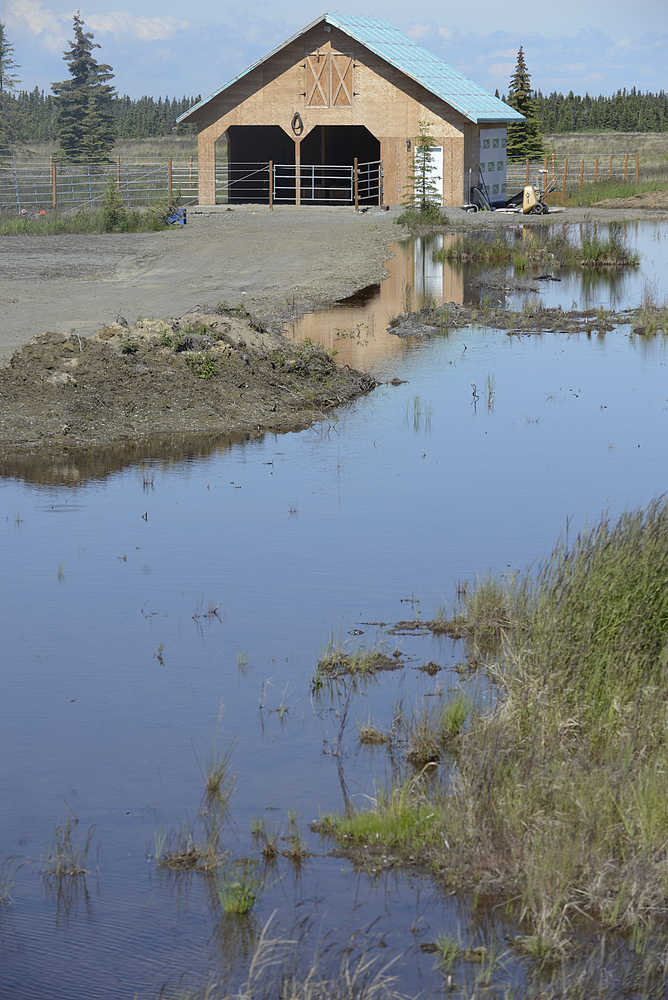A drainage ditch intended to move storm water out of a flood prone area along Kalifornsky Beach Road may not come to fruition any time soon.
The organization that was pushing the plan, the K-Beach Flood Mitigation Project, announced during a Monday meeting that it would be pulling out of the project, known as the Seventh Street Storm Water Conveyance Structure.
“Local residents along the downstream portion of the project had some reasonable and legitimate concerns,” said mitigation project President and Chief Executive Officer Kelly Lipinski. “We have taken those concerns seriously and feel that further feasibility studies need to be performed in order to fully address their concerns.”
The 2-mile drainage ditch would divert more than 23 million gallons of floodwater per day from Buoy Avenue to a beaver pond beside Eider Drive near Kalifornsky Beach Road. The ditch would parallel the eastern side of a section line easement.
However, some property owners concerned with the plan.
They questioned whether the ditch could adequately hold that amount of water without eroding the soil along its banks and causing problems for nearby homeowners.
The K-Beach High-Water Drainage Task Force is currently the only other entity that has expressed interest in picking up the project.
Hydrologist and task force co-chair Jim Munter said the group is unsure if they will be assuming management, but still supports the project.
At Monday’s meeting the majority of members were in attendance, but some were unable to attend due to prior conflicts. Those present did not want to make a decision without consulting absent member’s first, he said.
“There is too much pending,” Munter said. “We need to have other conversations first.”
Munter added that the task force had not been formed to manage a project with the scope of the conveyance structure.
Department of Natural Resources, Water Resources Section Chief Dave Schade, who is overseeing the project said he had was not aware that the project might be switching hands prior to the Monday meeting. He said the project would be put on hold until a decision is made at next month’s task force meeting.
A Temporary Water Use Act permit is required for the project through DNR. Last month, DNR solicited reviews of the project from several agencies as part of the permitting process.
The Kenai Peninsula Borough requested an extension of the review period from DNR in order to get public comments on the project. Dozens of residents filed comments with the borough.
“This mitigation project is quickly and poorly conceived,” resident Sammy Crawford wrote in an email to the borough. “We have no idea how it will impact the water level in our own property and our well water…I strongly oppose the permitting of this project.”
Other concerns included destruction to salmon habitat, erosion, safety, lack of a hydrological evaluations and financial burden, according to the final response the borough submitted to DNR.
Schade said a “litany of issues” remains unaddressed in the pending application for the ditch.
An April 16 email from DNR to Munter, who is also acting as a consultant for the mitigation project, identified need for detailed engineering designs, further information on what culverts would route the drainages and an updated letter of intent and progress to the Bureau of Land Management Office, BLM. BLM owns a parcel the structure would cut through.
Schade also said the issue of maintenance had not been resolved.
“The reality is twofold,” Schade said. “They were realizing this will cost serious dollars.”
Schade said it wasn’t clear in the project application which organization would be responsible for the cost and physical work necessary to maintain the structure. The Bridges Community Resources Network Inc, which the application was filed under, claimed no direct affiliation to the project. Bridges is a non-profit entity, which allows other organizations to operate under its 501(c)(3) designation.
The application also lacked an environmental impact statement, which is required by multiple entities, Schade said.
Munter said it is common for an organization to have a number of additional requirements at this point in the application process.
Agency and community feedback is taken into account as a project moves forward and designs are finalized, he said.
“We feel that the extensive requirements by each applicable agency to proceed are appropriate for a project of this magnitude,” Lipinski said.
Additionally, Lipinski said a feasibility study concerning potential long-term impacts of the proposed project has not been completed.
“The seventh street conveyance structure was only a small part of our work,” Lipinski said. “We are no longer interested in pursuing this particular project.”
Reach Kelly Sullivan at kelly.sullivan@peninsulaclarion.com

